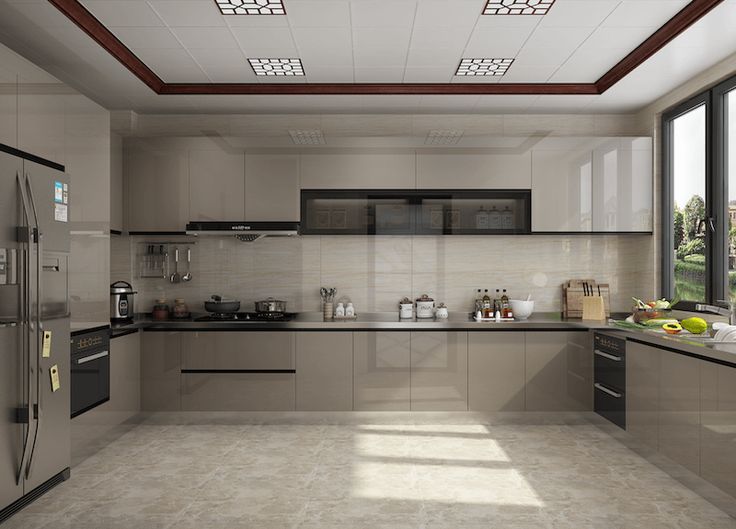In this blog, I’ll walk you through everything you need to know about acrylic sheets—how they differ from laminate, veneer, and glass, their pros and cons, the available thickness and finish options, and how to choose the best color for your space.
What Makes Acrylic Sheets Different?
Acrylic sheets are a versatile, high-quality finish material that comes in large sheets (8 feet by 4 feet) and can be applied directly to surfaces like plywood or HDHMR (High-Density High Moisture Resistant board). Compared to laminate or veneer, acrylic sheets are much easier to clean and maintain.
On the other hand, glass is more complex—it’s a heavier material and needs a more detailed installation process involving aluminum framing. The lacquer finish used on glass is similar to car paint, which makes it expensive and prone to damage if not handled properly.
Why Use Acrylic Sheets?
Acrylic gives a modern, sleek appearance and is available in a variety of colors like pastels and solids, making it perfect for contemporary interiors. Laminate, in comparison, offers a wider variety of textures and patterns, but lacks the clean, reflective finish that acrylic provides.
Acrylic sheets also offer a significant cost-saving when compared to lacquered glass, providing the same glossy finish for a fraction of the price. In terms of durability, acrylic sheets are much easier to clean, resistant to scratches, and long-lasting.
Advantages of Acrylic Sheets
- Scratch Resistant: Acrylic sheets are ideal for high-traffic areas like kids’ bedrooms or furniture surfaces. They won’t scratch easily, making them an excellent choice for long-term durability. If you’re using a brand that doesn’t claim to be scratch-resistant, it’s better to avoid it.
- Stain Resistant: Acrylic is easy to clean. For kitchen countertops or dining tables, you can wipe stains off easily with a wet cloth and regular cleaning products. Just avoid harsh chemicals like strong acids, and you’ll maintain the appearance for years.
- Heat Resistant: Acrylic is heat resistant, which makes it a great option for kitchen cabinets, as it can handle the temperature fluctuations that often occur in cooking spaces.
- Reflective Finish: The reflective surface of acrylic can make small spaces look larger and brighter. It’s perfect for bathrooms, lobby areas, and entrances, where natural light can bounce off surfaces and create a sense of openness.
Disadvantages of Acrylic Sheets
While acrylic is a fantastic option, there are some downsides:
- Price: Acrylic sheets tend to be more expensive than laminate. If you’re on a tight budget, laminate might be a more economical choice.
- Sunlight Exposure: Direct exposure to sunlight over time can cause acrylic to fade, although it will take a while. It’s best used in areas that aren’t exposed to harsh sunlight throughout the day.
Thickness Options for Acrylic Sheets
The thickness of acrylic sheets plays a huge role in both aesthetics and durability. Generally, you’ll find thicknesses like 1.25mm, 1.5mm, and even thicker options. The thicker the sheet, the more reflective and glass-like the finish will appear. A thickness of 1.5mm is considered the most value-for-money option, and it’s commonly used in both residential and commercial projects.
Available Finishes for Acrylic Sheets
Acrylic sheets come in various finishes, each suitable for different areas of your home:
- High Gloss Finish: This finish is ideal for kitchen cabinets, wardrobes, and other vertical furniture. It adds a clean, shiny look, but might require more frequent cleaning to maintain the shine. Avoid this finish on tabletops as it can show fingerprints and smudges.
- Matte Finish: Matte acrylic is best used for tabletops, and it’s also great in kitchens. However, it requires more maintenance, as it can show dust and dirt more easily than glossy finishes.
- Stone Finish: If you’re looking for a stone-like appearance, stone-finish acrylic is perfect for wall paneling. It mimics the natural texture and look of stone without the weight.
- Wooden Finish: While wooden finish acrylic sheets exist, many people prefer to use laminate or veneer for a more authentic wood grain feel. Wood finishes are ideal for more traditional settings.
- Mirror Finish: A trending option for modern spaces, mirror-finish acrylic is commonly used for wall panels and entrance doors. It creates a reflective surface that opens up the space and adds an element of luxury.
Best Colors for Acrylic Sheets in Your Kitchen
When selecting acrylic sheets for your kitchen or living room, it’s important to choose the right colors that suit your design style. Here are a few options from Advanced Laminates that I personally recommend:
- Gold Acrylic Sheet: A sleek, elegant choice for modern kitchens and bathrooms.
- Rose Gold Acrylic Sheet: A soft, warm tone that adds a touch of sophistication.
- Gold Mirror Acrylic Sheet: Perfect for creating a luxurious, reflective surface.
These shades are versatile and can match a wide range of interior designs, from contemporary to more traditional settings.
Conclusion
Acrylic sheets are a great choice for modern interiors due to their glossy finish, durability, and variety of design options. Whether you’re designing your kitchen, bathroom, or office, choosing the right finish and color is crucial. While acrylic might come at a higher price point than laminate, the long-term benefits—easy maintenance, scratch resistance, and modern aesthetics—make it a worthwhile investment.

